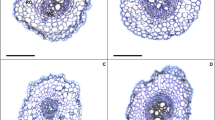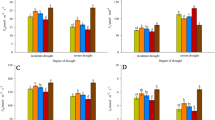Abstract
Foliar application of 24-epibrassinolide (EBL) has been used in different crops to reduce the adverse effects of water stress, but no studies have been found with soybean crop in the flowering stage, involving this bioregulator. Thus, this work aimed to evaluate the efficiency of the 24-epibrassinolide on growth, physiological mechanisms and antioxidant defense in soybean in the flowering phase under drought stress and rehydration. The EBL mitigated the effect of water stress on the shoot growth of soybean plants. In irrigated plants, EBL promoted improvements in gas exchange, photosynthetic efficiency, chlorophyll synthesis, and increase in shoot biomass. Plants under water deficit treated with EBL showed reductions in stomatal conductance and photosynthesis similar to those found in plants without EBL. However, the EBL mitigated the damage caused by water deficit in soybean, which was evidenced by the reduction of physiological damage to relative water content, leaf water potential, and effective equantum efficiency of photosystem II (ΦPSII). In addition, EBL minimized oxidative stress in plants, stimulating greater activities of the antioxidant enzymes catalase (CAT) and ascorbate peroxidase (APX),lower electrolyte leakage, and lipid peroxidation, which contributed to the lower degradation of chlorophylls. The EBL contributed with the higher production of dry matter and grain production in plants subjected to stress followed by rehydration. This set of information suggests that EBL not only partially alleviated the deleterious effect of drought stress on soybean in the flowering stage, but also participated in the post-stress recovery of soybean plants, which promoted increased growth, dry matter, and yield.







Similar content being viewed by others
References
Ahmed AHH, Darwish E, Alobaidy MG (2017) Impact of putrescine and 24- epibrassinolide on growth, yield and chemical constituents of cotton (Gossypium barbadense L.) plant grown under drought stress conditions. Asian J Plant Sci 16:9–23. https://doi.org/10.3923/ajps.2017.9.23
Ali Q, Ashraf M (2011) Induction of drought tolerance in maize (Zea mays L.) due to exogenous application of trehalose: growth, photosynthesis, water relations and oxidative defence mechanism. J Agron Crop Sci 197:258–271. https://doi.org/10.1111/j.1439-037X.2010.00463.x
Anjum SA, Ashraf U, Tanveer M, Khan I, Hussain S, Shahzad B, Wang LC (2017) Drought induced changes in growth, osmolyte accumulation and antioxidant metabolism of three maize hybrids. Front Plant Sci 8:1–11. https://doi.org/10.3389/fpls.2017.00069
Anwar A, Liu Y, Dong R, Bai L, Yu X, Li Y (2018) The physiological and molecular mechanism of brassinosteroid in response to stress: a review. Biol Res 51:46. https://doi.org/10.1186/s40659-018-0195-2
Baker NR (2008) Chlorophyll fluorescence: a probe of photosynthesis in vivo. Annu Rev Plant Biol 59:89–113. https://doi.org/10.1146/annurev.arplant.59.032607.092759
Barrs HD, Weatherley PE (1962) A re-examination of the relative turgidity technique for estimating water deficits in leaves. Aust J Biol Sci 15:413–428. https://doi.org/10.1071/BI9620413
Boerema A, Peeters A, Swolfs S, Vandevenne F, Jacobs S, Staes MP (2016) Soybean trade: balancing environmental and socio-economic impacts of an intercontinental market. PLoS ONE 11(5):5222. https://doi.org/10.1371/journal.pone.0155222
Buckley TN (2019) How do stomata respond to water status? New Phytol 224:21–36. https://doi.org/10.1111/nph.15899
Buezo J, Sanz-Saez Á, Moran JF, Soba D, Aranjuelo I, Esteban R (2019) Drought tolerance response of high-yielding soybean varieties to mild drought: physiological and photochemical adjustments. Physiol Plant 166:88–104. https://doi.org/10.1111/ppl.12864
Choudhary SP, Yu JQ, Yamaguchi-Shinozaki K, Shinozaki K, Tran LSP (2012) Benefits of brassinosteroid crosstalk. Trends Plant Sci 17:594–605. https://doi.org/10.1016/j.tplants.2012.05.012
CONAB (2021). Companhia Nacional de Abastecimento. Perspectivas para agropecuária (Safra 2021/2022), v. 9, p. 85, 2021. Available in: <http://www.conab.gov.br>, access in april 2022.
Desoky ESM, Mansour E, Ali MMA, Yasin MAT, Abdul-Hamid MIE, Rady MM, Ali EF (2021) Exogenously used 24-epibrassinolide promotes drought tolerance in maize hybrids by improving plant and water productivity in an arid environment. Plants 10:354. https://doi.org/10.3390/plants10020354
Dhindsa RS (1982). Inhibition of protein syntehsis by products of lipid peroxidastion, - Phytochemistry 21:309 –313. Doi: https://doi.org/10.1016/S0031-9422(00)95257-9
Dobrikova AG, Vladkova RS, Rashkov GD, Todinova SJ, Krumova SB, Apostolova EL (2014) Effectsofexogenous 24-epibrassinolide onthephotosyntheticmembranesunder non-stress conditions. Plant Physiol. Biochem 80:75–82. https://doi.org/10.1016/j.plaphy.2014.03.022
Dong S, Jiang Y, Dong Y, Wang L, Wang W, Ma Z, Yan C, Ma C, Liu L (2019) A studyonsoybean responses to drought stress andrehydration. Saudi J BiolSci 26:2006–2017. https://doi.org/10.1016/j.sjbs.2019.08.005
Du Y, Zhao Q, Chen L, Yao X, Zhang W, Zhang B, Xie F (2020) Effect of drought stress on sugar metabolism in leaves and roots of soybean seedlings. Plant Physiol Biochem 146:1–12. https://doi.org/10.1016/j.plaphy.2019.11.003
EMBRAPA (2013) Brazilian Agricultural Research Corporation. Brazilian system of soil classification, 3rd edn. Embrapa TechnologicalInformation, Brasília
Gassen DN (2002) O índice de área foliar em soja. Agrolink. https://www.agrolink.com.br/colunistas/o-indice-de-area-foliar-em-soja_383603.html. Accessed May 2022
Gill MB, Cai K, Zhang G, Zeng F (2017) Brassinolidealleviatesthe drought-induced adverse effects in barleybymodulationofenzymaticantioxidantsandultrastructure. Plant GrowthRegul 82:447–455. https://doi.org/10.1007/s10725-017-0271-6
Havir EA, Mchale NA (1987) Biochemicalanddevelopmentalcharacterizationofmultipleformsof catalase in tobaccoleaves. Plant Physiol 84:450–455. https://doi.org/10.1104/pp.84.2.450
Heath RL, Packer L (1968) Photoperoxidation in isolatedchloroplasts. I. Kineticsandstoichiometryoffattyacidperoxidation. ArchBiochemBiophys 125:189–198
Holá D (2011). Brassinosteroids and photosynthesis. In Brassinosteroids: A Classof Plant Hormone; Hayat, S., Ahmad, A., Eds.; Springer Science & Business Media: Berlin/Heidelberg, German, pp. 143–192. Doi: https://doi.org/10.1016/j.clet.2021.100197
Huang L, Zhang L, Zeng R, Wang X, Zhang H, Wang L, Liu S, Wang X, Chen T (2020) Brassinosteroid priming improves peanut drought tolerance via eliminating inhibition on genes in photosynthesis and hormone signaling. Genes 11:919. https://doi.org/10.3390/genes11080919
Khamsuk O, Sonjaroon W, Suwanwong S, Jutamanee K, Suksamrarn A (2018) Effectsof 24-epibrassinolide andthesyntheticbrassinosteroidmimicon chili pepperunder drought. Acta Physiol Plant 40:1–12. https://doi.org/10.1007/s11738-018-2682-z
Khan I, Awan SA, Ikram R, Rizwan M, Akhtar N, Yasmin H, Sayyed RZ, Ali S, Ilyas N (2021) Effects of 24-epibrass inolide on plant growth, antioxidants defense system, and endogenous hormones in two wheat varieties under drought stress. Physiol Plant 172:696–706. https://doi.org/10.1111/ppl.13237
Li J, Yang P, Gan Y, Yu J, Xie J (2015) Brassinosteroid alleviates chilling-induced oxidative stress in pepper by enhancing antioxidation systems and maintenance of photosystem II. Acta Physiol Plant 37:1–11. https://doi.org/10.1007/s11738-015-1966-9
Liaqat S, Umar S, Saffeullah P, Iqbal N, Siddiqi TO, Khan MIR (2020) Protective effect of 24-epibrassinolide on barley plants growing under combined stress of salinity and potassium deficiency. J Plant Growth Regul 39:1543–1558. https://doi.org/10.1007/s00344-020-10163-8
Lichtenthaler HK, Wellburn AR (1983) Determinations of total carotenoids and chlorophylls a and b of leaf extracts in different solvents. Biochem Soc Trans 11:591–592
Lima JV, Lobato AKS (2017) Brassinosteroids improve photosystem II efficiency, gas exchange, antioxidant enzymes and growth of cowpea plants exposed to water deficit. Physiol Mol Biol Plants 23:59–72. https://doi.org/10.1007/s12298-016-0410-y
Lin WH (2020) Designed manipulation of the brassinosteroid signal to enhance crop yield. Front Plant Sci 11:854. https://doi.org/10.3389/fpls.2020.00854
Maia Júnior SDO, Andrade JR, Nascimento R, Lima RF, Castro Bezerra CV, Ferreira VM (2022) Brassinosteroid application increase stomato tolerance to salinity by changing the effects of stress on membrane integrity and gas exchange. Acta Sci Agron 44:55647–55647. https://doi.org/10.4025/actasciagron.v44i1.55647
Marković S, Petrović M, Đukić N (2020) Variability of malondialdehyde content and yield elements in Triticum aestivum L under heat stress conditions. Kragujevac J. Sci. 42:45–54
Martins AC, Larré CF, Bortolini F, Borella J, Eichholz R, Delias D, Amarante L (2018) Tolerânciaaodéficithídrico: Adaptaçãodiferencial entre espéciesforrageiras. Iheringia, Série Botânica 73:228–239
Maxwell K, Johnson GN (2000) Chlorophyll fluorescence: a pratical guide. J Exp Bot 51:659–668. https://doi.org/10.1093/jexbot/51.345.659
Morales RGF (2012) Resistênciaaodéficithídricoemfamílias de tomateiroderivados de Solanumpennellii. Universidade Federal de Lavras, UFLA, Lavras, Tese (DoutoradoemProdução Vegetal), p 93p
Nakano Y, Asada K (1981) Hydrogen peroxide is scavenged by ascorbate-sepecific peroxidase in spinach choloroplasts. Plant Cell Physiol 22:867–880. https://doi.org/10.1093/oxfordjournals.pcp.a076232
Neumaier N, Nepomuceno AL, Farias JRB, Oya T (2000). Estadios de desenvolvimento da cultura de soja. Embrapa Soja-Capítuloemlivrocientífico (ALICE), 44p.
Nolan TM, Vukašinović N, Liu D, Russinova E, Yin Y (2020) Brassinosteroids: multidimensional regulators of plant growth, development, and stress responses. Plant Cell 32:295–318. https://doi.org/10.1105/tpc.19.00335
Pereira YC, Rodrigues WS, Lima EJA, Santos LR, Silva MHL, Lobato AKS (2019) Brassinosteroids increase electron transport and photosynthesis in soybean plants under water deficit. Photosynthetica 57:181–191. https://doi.org/10.32615/ps.2019.029
Perez-Borroto LS, Guzzo MC, Posada G, PeñabMalaveraAN CAP, Gonzalez-Olmedo JL, Coll-García Y, Pardo EM (2022) A brassinosteroid functional analogue increases soybean drought resilience. Sci Rep 12(1):1–14. https://doi.org/10.1038/s41598-022-15284-6
Ribeiro DGDS, Silva BRSD, Lobato AKDS (2019) Brassinosteroids induce tolerance to water deficit in soybean seedlings: contributions linked to root anatomy and antioxidant enzymes. Acta Physiol Plant 41:1–11. https://doi.org/10.1007/s11738-019-2873-2
Seixas CDS, Neumaier N, Balbinot Junior AA, Krzyzanowski FC, Leite RDC (2020). Tecnologias de produção de soja. Embrapa Soja-Sistema de Produção (INFOTECA-E).
Seldimirova OA, Bezrukova MV, Galin IR, Lubyanova AR, Shakirova FM, Kruglova NN (2017) 24-epibrassinolideeffectson in vitro callustissueformation, growth, andregeneration in wheatvarietieswithcontrasting drought resistance. Russ J Plant Physiol 64:919–929. https://doi.org/10.1134/S1021443717060085
Shahana T, Rao PA, Ram SS, Sujatha E (2015) Mitigation of drought stress by 24- epibarassinolide and 28-homobrassinolide in pigeon pea seedlings. Int J MultiCurr Res 3:904–991
Siddiqui H, Hayat S, Bajguz A (2018) Regulation of photosynthesis by brassinosteroids in plants. Acta Physiol Plant 40:59. https://doi.org/10.1007/s11738-018-2639-2
Tanveer M, Shahzad B, Sharma A, Khan EA (2019) 24-Epibrassinolide application in plants: an implication for improving drought stress tolerance in plants. Plant PhysiolBiochem 135:295–303. https://doi.org/10.1016/j.plaphy.2018.12.013
Vardhini BV (2017) Modifications of morphological and anatomical characteristics of plants by application of brassinosteroids under various abiotic stress conditions-A review. Plant Gene 11:70–89. https://doi.org/10.1016/j.plgene.2017.06.005
Xiong Y, Wu B, Du F, Guo X, Tian C, Hu J, Lü S, Long M, Zhang L, Wang Y, Jiao Y (2021) A crosstalk between auxin and brassinosteroid regulates leaf shape by modulating growth anisotropy. Mol Plant 14:949–962. https://doi.org/10.1016/j.molp.2021.03.011
Yuan GF, Jia CG, Li Z, Sun B, Zhang LP, Liu N, Wang QM (2010) Effect of brassinosteroids on drought resistance and abscisic acid concentration in tomato under water stress. Sci Hortic 126:103–108. https://doi.org/10.1016/j.scienta.2010.06.014
Zhang M, Zhai Z, Tian X, Duan L, Li Z (2008) Brassinolide alleviated the adverse effect of water deficits on photosynthesis and the antioxidant of soybean (Glycine max L.). Plant Growth Regul 56:257–264. https://doi.org/10.1007/s10725-008-9305-4
Author information
Authors and Affiliations
Contributions
JCAN, GCJ, and LE designed the study and contributed to revise the manuscript. VMF, JMTMB, and CM S designed and performed research, wrote and revised the manuscript, and wrote the paper. ALJS, NSO, and JVS carried out the experiments and tabulation of the data.
Corresponding author
Ethics declarations
Conflict of interest
The authors declare that there is no conflict of interest. The authors declare that the work described has not been published previously and is not under consideration for publication elsewhere, in whole or in part.
Additional information
Handling Editor: Anket Sharma
Publisher's Note
Springer Nature remains neutral with regard to jurisdictional claims in published maps and institutional affiliations.
Rights and permissions
Springer Nature or its licensor (e.g. a society or other partner) holds exclusive rights to this article under a publishing agreement with the author(s) or other rightsholder(s); author self-archiving of the accepted manuscript version of this article is solely governed by the terms of such publishing agreement and applicable law.
About this article
Cite this article
Barros, J.M.T.M., Ferreira, V.M., dos Santos, C.M. et al. 24-Epibrassinolide in the Flowering Stage Mitigates the Effects of Temporary Drought Stress and Favors the Post-stress Recovery in Soybean. J Plant Growth Regul 42, 7038–7053 (2023). https://doi.org/10.1007/s00344-023-10995-0
Received:
Accepted:
Published:
Issue Date:
DOI: https://doi.org/10.1007/s00344-023-10995-0




